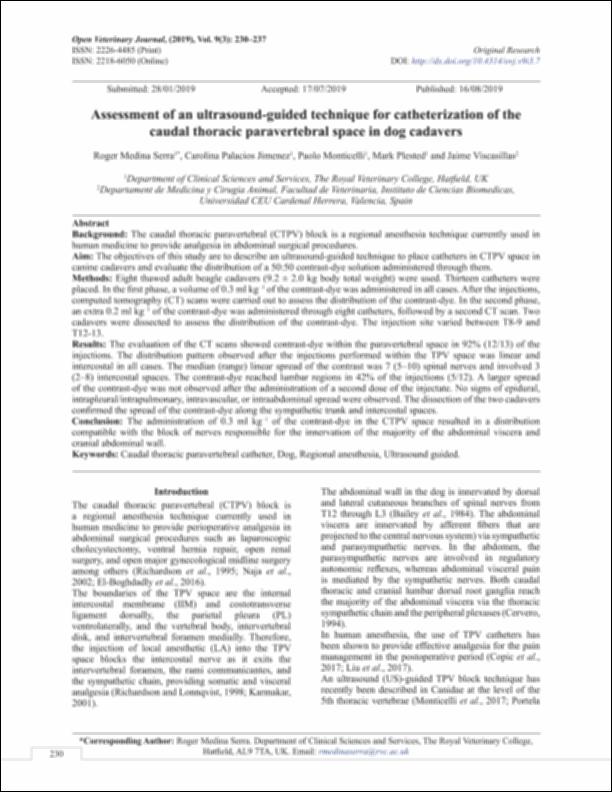Por favor, use este identificador para citar o enlazar este ítem:
http://hdl.handle.net/10637/10874Assessment of an ultrasound-guided technique for catheterization of the caudal thoracic paravertebral space in dog cadavers
| Título : | Assessment of an ultrasound-guided technique for catheterization of the caudal thoracic paravertebral space in dog cadavers |
| Autor : | Medina Serra, Roger Palacios Jiménez, Carolina Monticelli, Paolo Plested, Mark Viscasillas Monteagudo, Jaime |
| Materias: | Dogs - Anesthesia.; Anestesia veterinaria.; Veterinary anesthesia.; Vértebras dorsales - Cateterismo.; Ultrasonics.; Thoracic vertebrae - Catheterization.; Anestesia local.; Local anesthesia.; Ultrasonidos.; Perros - Anestesia. |
| Editorial : | University of Tripoli, Faculty of Veterinary Medicine. |
| Citación : | Medina-Serra, R., Palacios-Jimenez, C., Monticelli, P., Plested, M. & Viscasillas, J. (2019). Assessment of an ultrasound-guided technique for catheterization of the caudal thoracic paravertebral space in dog cadavers. Open Veterinary Journal, vol. 9, n. 3, pp. 230-237. (jul.). DOI: http://dx.doi.org/10.4314/ovj.v9i3.7 |
| Resumen : | Background: The caudal thoracic paravertebral (CTPV) block is a regional anesthesia technique currently used in human medicine to provide analgesia in abdominal surgical procedures.Aim: The objectives of this study are to describe an ultrasound-guided technique to place catheters in CTPV space in canine cadavers and evaluate the distribution of a 50:50 contrast-dye solution administered through them.Methods: Eight thawed adult beagle cadavers (9.2 ± 2.0 kg body total weight) were used. Thirteen catheters were placed. In the first phase, a volume of 0.3 ml kg−1 of the contrast-dye was administered in all cases. After the injections, computed tomography (CT) scans were carried out to assess the distribution of the contrast-dye. In the second phase, an extra 0.2 ml kg−1 of the contrast-dye was administered through eight catheters, followed by a second CT scan. Two cadavers were dissected to assess the distribution of the contrast-dye.The injection site varied between T8-9 and T12-13. Results: The evaluation of the CT scans showed contrast-dye within the paravertebral space in 92% (12/13) of the injections. The distribution pattern observed after the injections performed within the TPV space was linear and intercostal in all cases. The median (range) linear spread of the contrast was 7 (5–10) spinal nerves and involved 3 (2–8) intercostal spaces. The contrast-dye reached lumbar regions in 42% of the injections (5/12). A larger spread of the contrast-dye was not observed after the administration of a second dose of the injectate. No signs of epidural, intrapleural/intrapulmonary, intravascular, or intraabdominal spread were observed. The dissection of the two cadavers confirmed the spread of the contrast-dye along the sympathetic trunk and intercostal spaces.Conclusion: The administration of 0.3 ml kg−1 of the contrast-dye in the CTPV space resulted in a distribution compatible with the block of nerves responsible for the innervation of the majority of the abdominal viscera and cranial abdominal wall. |
| Descripción : | Este es el artículo que se ha publicado de forma definitiva en: https://www.openveterinaryjournal.com/OVJ-2019-01-023%20J.%20Brocal%20et%20al.pdf |
| URI : | http://hdl.handle.net/10637/10874 |
| Derechos: | http://creativecommons.org/licenses/by/4.0/deed.es |
| ISSN : | 2226-4485. 2218-6050 (Electrónico). |
| Fecha de publicación : | 1-jul-2019 |
| Centro : | Universidad Cardenal Herrera-CEU |
| Aparece en las colecciones: | Dpto. Medicina y Cirugía Animal |
Los ítems de DSpace están protegidos por copyright, con todos los derechos reservados, a menos que se indique lo contrario.


